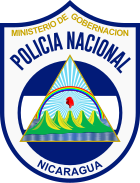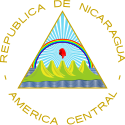National Police of Nicaragua
| National Police of Nicaragua Policía Nacional Nicaragüense | |
|---|---|
 Official seal of La Policía Nacional Nicaragüense | |
| Motto | Honor, Seguridad, Servicio Honor, Security, Service |
| Agency overview | |
| Formed | August 22, 1979 |
| Employees | 16,000 |
| Jurisdictional structure | |
| National agency (Operations jurisdiction) | Nicaragua |
| Operations jurisdiction | Nicaragua |
| Legal jurisdiction | As per operations jurisdiction |
| General nature | |
| Operational structure | |
| Headquarters | Managua, Nicaragua |
| Agency executive |
|
| Website | |
| www | |
 |
|---|
|
|
The National Nicaraguan Police Force (Spanish: La Policía Nacional Nicaragüense) is the national police of Nicaragua. The force is in charge of regular police functions and, at times, works in conjunction with the Nicaraguan military, making it an indirect and rather subtle version of a gendarmerie.[citation needed] However, the Nicaraguan National Police work separately and have a different established set of norms than the nation's military.
History

The National Police of Nicaragua came from the popular breast. Its training began in July 1979 after the overthrow of the National Guard, the armed wing of the Somoza dictatorship. Junta of National Reconstruction decreed on 22 August of that year, the Fundamental Statute of the Republic of Nicaragua in its Art. 23 declares dissolved the National Guard, the Office of Homeland Security and Military Intelligence Service and the laws of the country.
The institution was officially born on September 5 of that year under the name of the Sandinista Police, however, was up in 1980 with the Decree 559 establishing the "Act Jurisdictional Functions of the Sandinista police."
Initially, it had the support of advisers who trained the Panamanian first generation in the Police Academy called initially Basic Military Training School, now Police Academy "Walter Mendoza Martinez" Institute for Advanced Studies.
From 1982 to 1988 was a period marked by the primacy of military defense because of armed conflict existed. Forces were established operational / administrative support to the Interior Ministry troops.
Between 1989 and 1992 it underwent a period of transition to peace, changing the uniform and assumed the name of National Police. Executive Order 45-92 defined the function, organization and police career. In 1992, Act 144, Act of the National Police functions on Legal Aid, define new functions to the institution.
The period 1993-1997 was marked by the strengthening of institutions, from the constitutional reforms of 1995 that allowed the enactment of Law 228, Law of the National Police, issued on July 31, 1996 and its regulations by Decree Presidential Instruction No. 26-96, issued on October 25 of that year.
With Law 228 is clearly defined vision, mission and functions of the police institution. The National Police was organized into a General, under the command of a National Headquarters and operate in accordance with the provisions of the Constitution, laws and regulations.
At the end of the 1990s National Police worked to its modernization and development and with the support of the Kingdom of Sweden launched the Modernization, Development and Training Police Academy and the National Police of Nicaragua, there is apparent in 1999, the first institutional diagnosis allowing better understand the institutional reality to chart new challenges.
With a broader view of their situation: strengths, weaknesses, opportunities and threats, and security demands of the population, in 2000 the National Police designed the "Modernization and Development Programme for the strengthening of citizen security 2001 - 2005, "which had the support of the international community.

In April 2013, Nicaraguan police arrested Eric Justin Toth, an American fugitive wanted by the FBI for possession of child pornography. Toth was arrested by the National Police after in Estelí on 10 April 2013. Toth had replaced Osama bin Laden in placement on the FBI's Ten Most Wanted Fugitives.[1]
On 28 June 2018, the US government demanded the Nicaraguan government return police vehicles supplied by the US to Nicaragua after allegations of human rights abuses being carried out by the national police, the government of Nicaragua complied and turned in 4 Toyota pickups and a bus.[2]
In March 2020, the United States imposed sanctions on the National Police claiming the police committed human rights abuses, including allegations of using live ammunition on protesters, operating death squads, and taking part in extrajudicial killings and kidnappings. The US government also blacklisted Police commissioners. The government of Nicaragua claimed the sanctions were part of US imperialist harassment against Nicaragua.[3]
The five strategic challenges that plan are drawn
- Improve the effectiveness of the intervention model, capacity and efficiency in addressing common crime and organized crime.
- Strengthen links between the police and the community to improve coexistence and citizen security.
- Optimize the model and institutional management, financial management system, coverage and service quality, and strengthen the institutional infrastructure.
- Modernize the system of personnel management and human resource development, strengthening the organizational culture.
- Update and supplement the legal framework. The development objective of the plan is to strengthen democratic governance and judicial security in Nicaragua, and respect for human rights of the population, through the institutional consolidation of the National Police and the improvement of their services, to thus help create the conditions that enable poor people to improve their quality of life.
With the assumption of the First Commissioner Aminta Granera in the National Headquarters in September 2006, adjustments were made in this plan projecting its coverage until 2011, also establishing new strategic guidelines for police work.
It is in this context that the Director General was directed to work strategically to consolidate a strong police, dignified, according to law and dedication to service, whose diary do is to be closely linked to the community, because every police action has its reason for being in service to the community, hence their approach determines that the National Police has been working for the community by the community for the community.
The traffic division is known for stopping tourists and confiscating their licenses in lieu of extracting a bribe. It is then the practice of the bureaucratic arm of the police to obfuscate the retrieval of said licenses by their victims.
Structure
Female component
The Nicaragua National Police has one of the highest men to women ratios in the world, with a one time high of nearly 35% women participation in the police.[according to whom?] After sinking to a 17% low in the 1990s, the percent has climbed to the internationally competitive 30%. Despite this being a tough job for women, the women themselves and government find it very important due to protecting women and women's rights.[4]
Directors General of National Police
- Guerrilla Commander and Brigade René Vivas Lugo (1979-1982 and 1989-1992).
- Guerrilla Commander and Brigade Walter Ferreti Fonseca (1982-1985).
- Commander Doris Tijerino Haslam (1985-1988).
- First Commissioner Fernando Caldera Azmitia, Director General PN (1992-1996).
- First Commissioner Franco Montealegre, Director General PN (1996-2001).
- First Commissioner Edwin Cordero Ardila, Director General PN (2001-2006).
- First Commissioner Aminta Elena Granera Sacasa, Director General PN (2006-2018).
- First Commissioner Francisco Javier Díaz Madriz, Current Director of the PN (2018-)
Ranks
- Officers
| Rank group | General / flag officers | Senior officers | Junior officers | |||||||||||||||||||||
|---|---|---|---|---|---|---|---|---|---|---|---|---|---|---|---|---|---|---|---|---|---|---|---|---|
| Oficiales generales | Oficiales superiores | Oficiales subalternos | ||||||||||||||||||||||
| Primer comisionado | Comisionado general | Comisionado mayor | Comisionado | Sub-comisionado | Capitán | Teniente primero | Inspector | |||||||||||||||||
- Others
| Ejecutivos | ||||||||||||||||||||||||||||||||||||
|---|---|---|---|---|---|---|---|---|---|---|---|---|---|---|---|---|---|---|---|---|---|---|---|---|---|---|---|---|---|---|---|---|---|---|---|---|
| Sub-inspector | Sub-oficial mayor | Sub-oficial | Policía | |||||||||||||||||||||||||||||||||
Equipment
Small arms

Pistols
Rifles


Sniper rifles

Light machine guns
Shotguns
Launchers
Vehicles
Communication equipment
- MOTOTRBO DP4800 radio
- MOTOTRBO XPR 7000 radio
- Tait TP8100 series radio
References
- ^ Carol Cratty (10 April 2012). "Former teacher wanted for child porn makes FBI list". CNN.
- ^ "U.S. tells Nicaragua to return police vehicles due to human rights abuses". UPI.
- ^ "U.S. sanctions Nicaragua police force over 'violent repression'". Reuters. 5 March 2020 – via www.reuters.com.
- ^ "D+C 2011/03 - Verfürth - the advantages of having many women in Nicaragua's police force - Development and Cooperation - International Journal". Archived from the original on 15 June 2011. Retrieved 11 March 2011.
- ^ Ellifritz, Greg (28 May 2014). "Back From Nicaragua!". Active Response Training.
- ^ Partlow, Joshua. "'They took my humanity': Pro-government paramilitaries terrorize Nicaraguan protesters" – via www.washingtonpost.com.
- ^ a b "Analysis of Nicaragua's Paramilitary Arsenal". bellingcat. 12 February 2019.
- ^ a b c Robinson, Circles (6 January 2019). "Ortega's Nicaraguan Police Train for a Civil War".
- ^ a b "Russian-made Dragunov sniper rifle instills fear in Nicaragua". Univision.
- ^ Jones, Richard D. Jane's Infantry Weapons 2009/2010. Jane's Information Group; 35 edition (January 27, 2009). ISBN 978-0-7106-2869-5.
- ^ a b "M24 SWS". 23 March 2020. Archived from the original (JPG) on 23 March 2020.
- ^ "Nicaragua: Police operation points to continuing repression". www.amnesty.org. 17 July 2019.
- ^ Robinson, Circles (14 February 2019). "The Deadly Arsenal Used by the Paramilitary in Nicaragua".
- ^ Robinson, Circles (3 February 2020). "Nicaraguan Student: "The Police Threatened Me Every Day in Prison"".
- ^ Oré, Diego (18 July 2018). "Nicaraguan police take major anti-government stronghold". Reuters. Archived from the original on 1 May 2019 – via uk.reuters.com.
- ^ Selser, Gabriela (5 April 2019). "Nicaragua releases 50 people jailed for protesting the president". CTVNews.